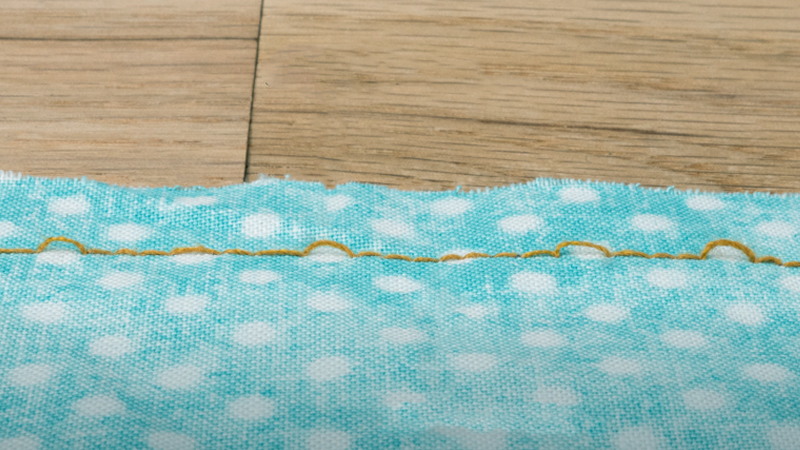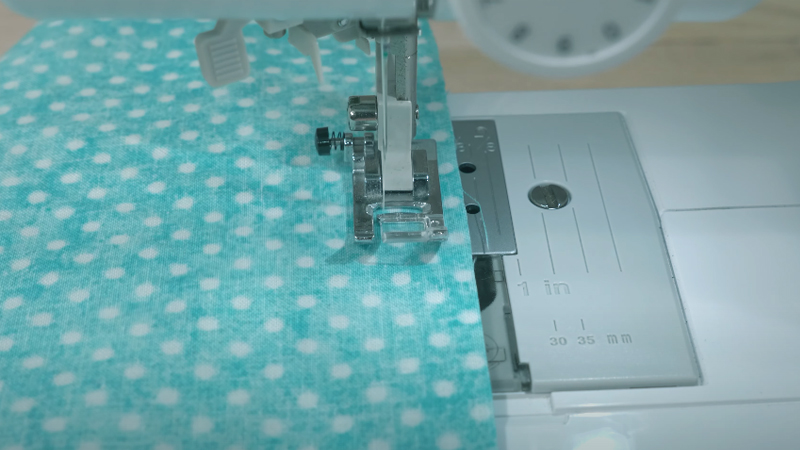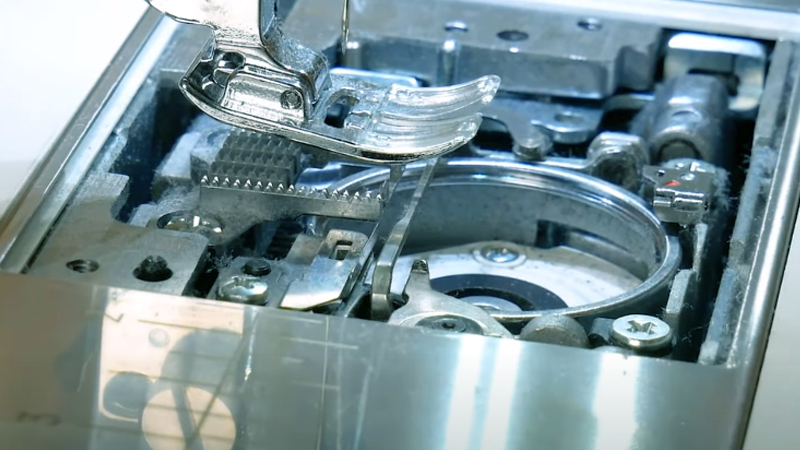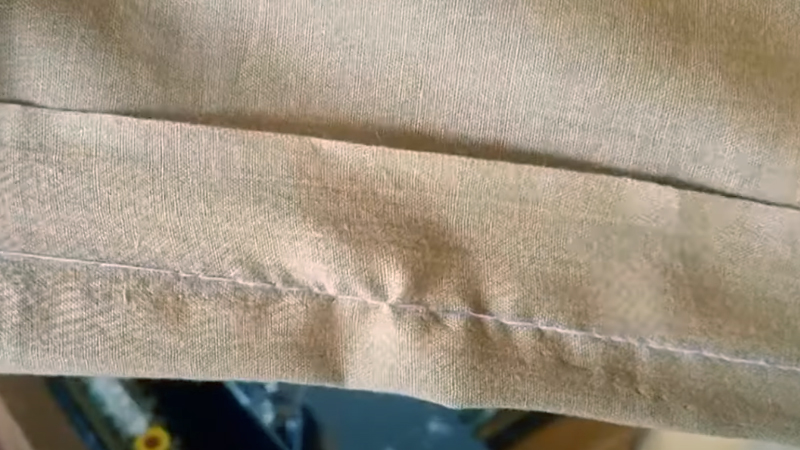Encountering skipped stitches while executing a blind stitch can be a perplexing and frustrating challenge for any sewing enthusiast.
The blind stitch, prized for its ability to create nearly invisible hems, relies on precise needlework. When this delicate balance is disrupted, it can lead to uneven seams and a less-than-professional finish.
Understanding the underlying causes behind this issue is crucial for effective troubleshooting. Factors like needle condition, thread tension, and fabric type all play pivotal roles.
This guide aims to unravel the mysteries of why blind stitches skip and offer practical insights to help you achieve seamless, impeccable results in your sewing endeavors.

What Is a Blind Stitch?
A blind stitch, also known as a blind hem stitch, is a sewing technique used to create inconspicuous hems on garments.
This specialized stitch is designed to join two pieces of fabric together while minimizing the visibility of the stitches on the right side of the fabric. It is commonly employed for tasks like hemming skirts, trousers, and curtains.
The blind stitch involves folding and tucking the fabric to conceal the raw edge and then sewing it in a way that the stitches are nearly invisible from the outside.
This technique is achieved using a blind stitch foot on a sewing machine or can be done by hand with a needle.
Why Is My Blind Stitch Skipping Stitches?
When your blind stitch sewing machine skips stitches, it can be a frustrating and perplexing issue to deal with.
There are several reasons why your blind stitch might be skipping stitches, and understanding these issues can help you troubleshoot and resolve the problem.
Here are:
Needle Issues
A dull or damaged needle is one of the most common reasons for skipped stitches. Over time, needles can become dull from use, and if they have any bent or burrs, they won’t pierce the fabric properly.
Replace the needle with a new one regularly and make sure you’re using the correct needle type for your fabric.
Thread Tension
Tension issues can cause skipped stitches. If the tension is too tight, the fabric may not feed through properly, leading to skipped stitches.
Conversely, if the tension is too loose, the thread may not properly lock the stitches, resulting in skipped stitches. Ensure that you have the correct thread tension for your fabric and machine settings.
Fabric Choice
Some fabrics are more prone to skipped stitches than others. Thin or delicate fabrics may not feed through the machine consistently, causing skipped stitches.
When you’re working with such fabrics, consider using a stabilizer or interfacing to provide more support.
Needle Size
Using the wrong needle size for your fabric can also lead to skipped stitches. A needle that’s too small may not adequately pierce the fabric, while a needle that’s too large can create holes and gaps in the stitches. Ensure you’re using the appropriate needle size for your project.
Thread Quality
Poor-quality thread can lead to skipped stitches as it may break or fray more easily. Invest in good-quality thread suitable for your fabric and sewing machine.
Machine Maintenance
Regular maintenance, such as cleaning and oiling your sewing machine, is crucial for its proper functioning. A dirty or poorly maintained machine may not feed the fabric smoothly, resulting in skipped stitches.
Stitch Length
Adjusting the stitch length incorrectly can also cause skipped stitches. Ensure that you have the right stitch length setting for your fabric. A longer stitch length might skip stitches on lightweight fabrics, while a shorter one can cause puckering on heavier fabrics.
Machine Speed
Sewing at an excessively high speed can sometimes cause skipped stitches, especially on intricate or delicate fabrics. Try slowing down your machine’s speed to see if it resolves the issue.
Effects of Blind Stitch Skipping Stitches

When a blind stitch skips stitches during sewing, it can have a range of undesirable effects on the finished garment. These irregularities can significantly impact the overall appearance and durability of the seam.
Let’s delve into the effects of blind stitch skipping stitches:
Uneven Hemlines
When a blind stitch skips stitches, it disrupts the seamless flow of the stitching process. This can lead to an uneven hemline, with sections of the fabric left inadequately secured.
These irregularities not only create a jagged appearance but also compromise the overall integrity of the garment.
Reduced Strength and Durability
A skipped blind stitch significantly weakens the structural integrity of the seam. The gaps left behind by the skipped stitches serve as stress points, making the seam vulnerable to fraying, tearing, or even unraveling over time.
Compromised Aesthetics
The purpose of a blind stitch is to create a finish that is discreet and inconspicuous. When stitches are skipped, it disrupts this intended effect. Instead of a clean, nearly invisible finish, the hem may become more noticeable.
Potential Fabric Damage
Skipped stitches can lead to fabric distortion or bunching, especially with delicate or easily manipulated materials. This can result in a misshapen or puckered appearance, which is both unsightly and potentially uncomfortable for the wearer.
Time-Consuming Repairs
Addressing skipped stitches is a meticulous process. It often involves unpicking and re-stitching sections of the seam.
This can be a time-consuming task, especially when working with intricate patterns or delicate fabrics. The need for such repairs can add significant hours to the completion of a sewing project.
Frustration and Disappointment
Discovering skipped stitches after investing time and effort into a sewing project can be disheartening.
It can lead to frustration, disappointment, and a sense of dissatisfaction with the final product. This emotional toll can be particularly pronounced when working on special or time-sensitive projects.
Additional Material Usage
In some cases, attempting to rectify skipped stitches may require additional fabric or interfacing.
This is especially true if the skipped stitches have resulted in weakened areas that need reinforcement. This not only increases material costs but can also lead to inconsistencies in the texture or appearance of the garment.
Potential Rejection of Finished Product
In professional settings, if the skipped stitches significantly compromise the integrity of the garment, it may not meet quality standards.
This can lead to rejection by clients or customers, potentially impacting your reputation as a seamstress or designer.
How to Fix the Blind Stitch Skipping Stitches?

Fixing a blind stitch that is skipping stitches can be a frustrating but manageable problem.
Here’s a step-by-step guide on how to address this issue:
Identify the Cause
Before attempting any fixes, it’s essential to pinpoint the root cause of the skipped stitches. Examine your sewing machine, thread, needle, and fabric to determine what might be causing the problem.
Common culprits include a dull or damaged needle, incorrect thread tension, and inappropriate needle or thread choice.
Replace the Needle
When you suspect that the needle is the issue, start by replacing it with a new one. Make sure you’re using the correct type and size of needle for your fabric.
A dull or damaged needle can cause skipped stitches, so a fresh needle can often resolve the problem.
Check Thread Tension
Incorrect thread tension is a common cause of skipped stitches. Ensure that your machine’s tension settings are adjusted correctly for the fabric you’re working with. Test your machine on a scrap piece of fabric to ensure the stitches are forming correctly.
Thread Quality
Low-quality or old thread can lead to skipped stitches. Ensure you are using good-quality thread suitable for your fabric. Also, check if the thread is correctly threaded through the machine, including through the tension discs.
Fabric Support
For delicate or stretchy fabrics that tend to skip stitches, consider using a stabilizer or interfacing. These materials provide additional support to the fabric and can prevent skipped stitches.
Machine Maintenance
Regularly clean and oil your sewing machine as per the manufacturer’s instructions.
A clean and well-maintained machine is less likely to cause stitching issues due to friction or dirt buildup.
Adjust Stitch Length
Sometimes, changing the stitch length can help alleviate skipped stitches. Experiment with different stitch lengths, both shorter and longer, to see if this makes a difference.
Certain fabrics may require slight adjustments to the stitch length to prevent skipping.
Sew at a Moderate Speed
Sewing too fast can sometimes lead to skipped stitches, especially when working with intricate or delicate fabrics.
Try slowing down your sewing machine’s speed to allow the machine to catch each stitch properly.
Test on Scrap Fabric
Before resuming your project, always test your adjustments on a scrap piece of the same fabric. This allows you to ensure that the problem has been resolved before sewing on your actual garment.
Professional Service
When you’ve tried the above steps and still experience skipped stitches, it may be time to consult a professional sewing machine technician. They can thoroughly inspect and service your machine to address any underlying mechanical issues.
Tips for Preventing Skipped Stitches

Achieving smooth, consistent stitch is a hallmark of professional-quality sewing. Skipped stitches can be a frustrating issue to encounter, but with the right techniques, they can be largely prevented.
Here are some valuable tips to help you avoid skipped stitches and ensure your sewing projects turn out beautifully:
Use High-Quality Thread
Investing in a good-quality thread is essential. Cheap or old thread is more likely to break or fray, leading to skipped stitches. Opt for thread that matches the weight and composition of your fabric.
Choose the Right Needle
Selecting the correct needle for your fabric is crucial. A dull or incorrect needle can easily cause skipped stitches. For instance, use ballpoint needles for knits and sharp needles for woven fabrics.
Maintain Your Sewing Machine
Regular cleaning and oiling of your sewing machine keep it in optimal condition. This reduces the chances of friction-related issues that can lead to skipped stitches.
Thread Properly
Ensure the thread is correctly threaded through the machine, including passing through the tension discs and the needle’s eye. Proper threading minimizes tension-related problems.
Check Needle Position
Ensure that the needle is properly centered and aligned with the presser foot. An off-center needle can result in skipped stitches.
Adjust Thread Tension
Proper thread tension is critical. Adjust it according to the fabric you’re working on. Tighten the tension if the stitches are loose and loosen it if the fabric is puckering.
Select the Right Stitch Type
Use the appropriate stitch type for your project. For example, use a stretch stitch for knit fabrics and a straight stitch for woven materials.
Choose Suitable Fabric
Be mindful of the fabric you’re using. Thin, stretchy, or delicate fabrics may require additional support, such as a stabilizer or interfacing, to prevent skipped stitches.
Check Bobbin Tension
Ensure that the bobbin tension is properly adjusted. An imbalanced tension between the top and bottom threads can lead to skipped stitches.
Maintain a Moderate Sewing Speed
Sew at a consistent and moderate speed. Rushing through the sewing process can lead to skipped stitches, especially on delicate or intricate projects.
Test on Scrap Fabric
Always conduct a test on a scrap piece of the same fabric before sewing your actual project. This allows you to ensure that the issue has been resolved before committing to your main piece.
FAQs
Why is my blind stitch skipping stitches?
Blind stitches may skip due to factors like a dull needle, incorrect thread tension, or using the wrong needle type for the fabric.
Can using low-quality thread cause skipped stitches?
Yes, low-quality or old threads can lead to skipped stitches. Investing in a good-quality thread is important for consistent stitching.
How often should I replace the needle to prevent skipped stitches?
It’s recommended to replace the needle after every 8-10 hours of sewing or when it shows signs of dullness or damage.
What can I do if my blind stitch is skipping stitches on delicate fabrics?
Consider using a stabilizer or interfacing to provide additional support to the fabric and prevent skipped stitches.
Could incorrect thread tension be causing my blind stitch to skip stitches?
Yes, incorrect thread tension is a common culprit. Adjusting the tension to match your fabric can help prevent skipped stitches.
Wrap Up
Understanding the intricacies of blind stitch sewing and the potential challenges, like skipped stitches, is crucial for achieving professional-grade results.
By delving into factors such as needle condition, thread tension, and fabric choice, sewists can troubleshoot and rectify this common issue.
Regular maintenance of equipment, coupled with thoughtful material selection, plays a pivotal role in preventing skipped stitches. Patience and precision in adjusting settings further contribute to seamless, impeccable finishes.
With these insights, you can confidently navigate the world of blind stitching, ensuring each project showcases the craftsmanship and attention to detail it deserves.
Embrace these techniques, and let your sewing endeavors flourish with flawless, nearly invisible hems.
Leave a Reply